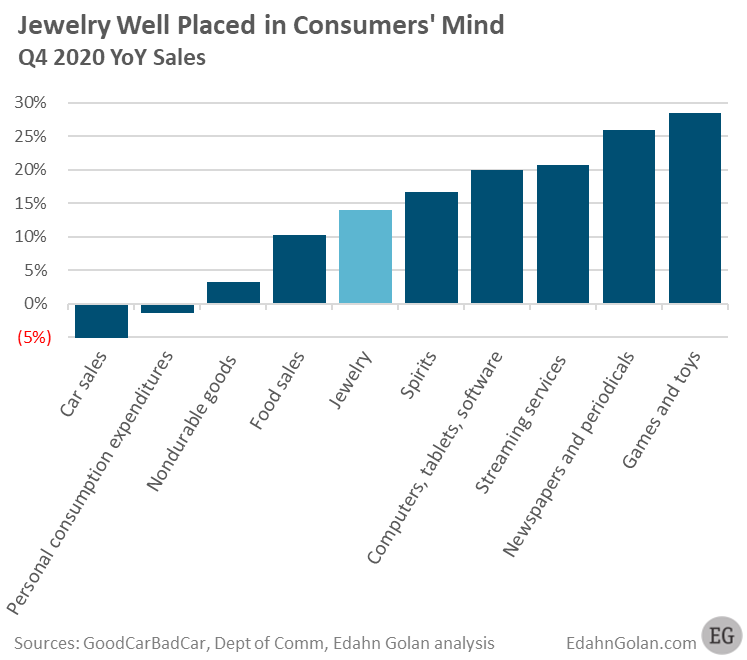US jewellery sales declined 0.3% to $62,678 million in 2020. For sales to be practically flat following an exceptionally challenging year is not bad at all. And for sales to skyrocket in the fourth quarter is far more than just “not bad”.
During the last three months of 2020, sales totalled an estimated $24.7 billion, a 13.3% year-over-year rise. By comparison, in the previous ten years, Q4 sales rose on average just 1.9%.
Why It Matters
In recent weeks, the talk in the market has been optimistic, but laced with a thick thread of ominous storm clouds. Basically, the view is this: travel was banned, vacations didn’t take place, the stock market boomed and, therefore, people had cash in their pockets and sought where to spend it. In brief, this situation resulted in pent-up demand.
But is that all there is to it? Because if it is, that means that it is perfectly reasonable to conclude that jewellery sales will decline as soon as travel is restored.
Here is an alternative explanation: Pent-up demand really speaks to deeper needs and desires. After all, buying jewellery online is not easy – certainly not as easy as buying something perfectly standard and highly desirable such as a car.
From a social standpoint, you could argue that jewellery does not need marketing. We sell it to ourselves. But from a consumerism standpoint, we should conclude that there is a strong underlying desire for jewellery. What is needed is to highlight it. That is why jewellery was a hit.
Putting It in Context
- And yet, US cars sales fell 16.1% to 14.67 million units last year.
- Total US personal consumption expenditures declined 2.7% in 2020 and by 1.4% in the last quarter.
- Although overeating was considered the curse of the pandemic period, food sales for home consumption rose less than jewellery – up 10.5%.
- Expenditure on nondurable goods was up just 3.3% in the fourth quarter.
If sales of an all-American product such as cars fell, then should we not wonder why jewellery was such a hit?
The Real 2020 Competition
Stay-at-home products did very well.
- Computers, tablets, and software sales were up 15.3% during the year and 20% in Q4.
- Games and toys sales jumped 20% in 2020.
- Expenditures on newspapers, periodicals, and streaming services leaped 23%.
- Alcohol sales increased too, especially spirits, which rose 15%.
What really soared was investments in the stock market, with expenditures on exchange equities up 40% and over-the-counter equities flying high at 84%.
What Does it Mean?
Jewellery is the odd product on this list. Not a necessity like food, not a pastime like toys, streaming media, or spirits, not a utility like a car. Jewellery is a choice – an expression of individuality, a way to feel good about ourselves, and a reward all wrapped in one.
The Key Takeaway
From a social standpoint, you could argue that jewellery does not need marketing. We sell it to ourselves. But from a consumerism standpoint, we should conclude that there is a strong underlying desire for jewellery. What is needed is to highlight it. That is why jewellery was a hit.
As an industry, we need to remind consumers to tap into that desire and to add jewellery to our annual basket of annual expenditures, be it to celebrate a rare occasion or just to enjoy a small private moment. Our marketing should focus on the larger and small joys of life.
—
Edahn Golan is a veteran of the diamond industry, researching and writing about it since 2001. He specialises in a wide range of topics relating to this unique industry, including the way it operates, wholesale and retail polished diamond prices, the rough diamond sector of the diamond pipeline and investment in diamonds.
Edahn has written extensively about these subjects and many others, including the Kimberley Process (KP), financing issues, ethics and changes in the way the diamond industry has operated over the years.
Prior to founding Edahn Golan Diamond Research & Data, Edahn joined the IDEX Online Group to form the news and research department of its newly launched website.
Over the years, Edahn has advised leading diamond firms, industry bodies, investment companies and governmental agencies, writing research papers on topics ranging from provenance analysis of fancy color diamonds and the diamond’s contribution to local economies to the viability of investment in diamonds.


